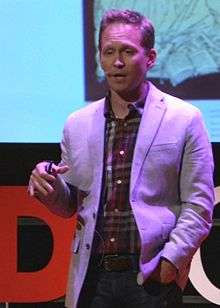W. Christopher Winter
| W. Christopher Winter | |
|---|---|
 Dr. W. Christopher Winter lecturing in 2014. | |
| Born |
December 27, 1972 Roanoke, Virginia, United States |
| Residence | United States |
| Institutions | Charlotesville Neurology and Sleep Medicine, Martha Jefferson Hospital |
| Education | Emory University School of Medicine |
| Alma mater | University of Virginia |
|
Website | |
William Christopher Winter (born December 27, 1972) is a US sleep researcher, neurologist, and authority regarding sleep and athletic performance.[1] A 2010 article in Trail Runner magazine described Dr. Winter as "the leading expert in the field of sleep disruption, in athletes and issues related to travel."[2] He is credited with coining the term circadian advantage after studying the effects of travel on Major League Baseball teams.[3] He studied the effect of sleep timing preference on Major League Baseball pitcher performance,[4] and hitting performance.[5] In 2013, his research linked the sleepiness of Major League Baseball player to a reduced career longevity.[6][7] This work led to research into sleepiness as a predictor of NFL Draft value in which the sleep of 560 Atlantic Coast Conference (ACC) football players and their eventual draft success was studied.[8]
To date, he has advised numerous professional athletic organizations,[9] most notably the San Francisco Giants who publicly commented on his role with their club in 2012 [10] and 2014.[11] It has been documented that he has also worked with the Oklahoma City Thunder and New York Rangers.[12] Dr. Winter, described as "sleep whisperer"[13] is referenced repeatedly by Arianna Huffington in her 2016 book The Sleep Revolution: Transforming Your Life, One Night at a Time.[14]
Dr. Winter's debut book, The Sleep Solution: Why Your Sleep is Broken and How to Fix It, is scheduled for release by Penguin Random House on April 4, 2017.[15]
Selected publications
- Jaffee, MS; Winter, WC (2015). "Sleep disturbances in athletic concussion". Brain Injury. 29 (2): 221–217. doi:10.3109/02699052.2014.983978. PMID 25587746.
- Winter, WC; Hammond, WR; Green, NH; Zhang, Z; Bliwise, DL (2009). "Measuring circadian advantage in Major League Baseball: a 10-year retrospective study". International Journal of Sports Physiology and Performance. 4 (3): 394–401. PMID 19953826.
- Morgan, JC; Winter, WC; Wooten, GF (2004). "Amphetamine-induced chorea in attention deficit-hyperactivity disorder". Movement Disorder. 19 (7): 840–842. doi:10.1002/mds.20081. PMID 15254949.
- Winter, WC; Juel, VC (2003). "Hypoglossal neuropathy in hereditary neuropathy with liability to pressure palsy". Neurology. 61 (8): 1154–1155. doi:10.1212/01.wnl.0000086808.56096.da. PMID 14581692.
- Ranta, A; Winter, WC; Login, IS (2003). "Extracranial hypoglossal schwannoma". Neurology. 60 (12): E11. doi:10.1212/01.WNL.0000060184.63911.B0. PMID 12821768.
- Qureshi, AI; Winter, WC; Bliwise, DL (1999). "Sleep fragmentation and morning cerebrovasomotor reactivity to hypercapnia.". American Journal of Respiratory and Critical Care Medicine. 160 (4): 1244–1247. doi:10.1164/ajrccm.160.4.9810111. PMID 10508814.
- Lonergan, RP; Ware, JC; Atkinson, RL; Winter, WC; Suratt, PM (1998). "Sleep apnea in obese miniature pigs". Journal of Applied Physiology. 84 (2): 531–536. PMID 9475862.
- Winter, WC; Gampper, T; Gay, SB; Suratt, PM (1997). "Lateral pharyngeal fat pad pressure during breathing in anesthetized pigs". Journal of Applied Physiology. 83 (3): 688–694. PMID 9292450.
- Winter, WC; Gampper, T; Gay, SB; Suratt, PM (1996). "Lateral pharyngeal fat pad pressure during breathing". Sleep. 19 (10): 178–179. PMID 9085504.
- Winter, WC; Gampper, T; Gay, SB; Suratt, PM (1995). "Enlargement of the lateral pharyngeal fat pad space in pigs increases upper airway resistance". Journal of Applied Physiology. 79 (3): 726–731. PMID 8567510.
References
- ↑ Matt McCarthy (13 April 2015). "Science of nap time: Seeking an edge in the most basic of all human needs". Sports Illustrated. Retrieved 7 May 2016.
- ↑ Mackenzie Lobby (1 August 2010). "Get In Rhythm". Trail Runner. Retrieved 9 May 2016.
- ↑ "Major League Baseball Teams With Greater Circadian Advantage Are More Likely To Succeed". Science Daily. 10 June 2008. Retrieved 6 May 2016.
- ↑ "Sleep preference can predict performance of Major League Baseball pitchers". Science Daily. 11 June 2010. Retrieved 7 May 2016.
- ↑ Erik Malinowski (13 June 2011). "Do Athletes Play Better at Night? Better Sleep on It". Details. Retrieved 7 May 2016.
- ↑ "Fatigue and sleep linked to Major League Baseball performance and career longevity". Science Daily. 31 May 2013. Retrieved 9 May 2016.
- ↑ "Sleep Linked With MLB Career Longevity". Huffington Post. 4 June 2013. Retrieved 9 May 2016.
- ↑ Colby Stong (November 2012). "Can Quality of Sleep Help Predict Productivity of NFL Draft Picks?". Neurology Reviews. Retrieved 9 May 2016.
- ↑ Joseph Hooper (1 May 2016). "The Man Who Helps Pro Athletes Fall Asleep". Men's Journal. Retrieved 6 May 2016.
- ↑ Jason Koebler (15 June 2012). "The New Moneyball? It's Major League Sleep". US News & World Report. Retrieved 6 May 2016.
- ↑ "Sweet Dreams: Sleep Expert Helps Giants in October". Associated Press. 25 October 2014. Retrieved 6 May 2016.
- ↑ Jamie Lisanti (22 October 2014). "How doctors and dietitians help NBA players fight jet lag with nutrition". Sports Illustrated. Retrieved 7 May 2016.
- ↑ Arianna Huffington (26 February 2015). "My Q and A With W. Chris Winter, Sleep Whisperer to Some of the World's Top Athletes". Huffington Post. Retrieved 9 May 2016.
- ↑ Arianna Huffington (17 March 2016). "How to Fight Jet Lag: Exclusive Excerpt From Arianna Huffington's 'The Sleep Revolution'". Marriott Traveler. Retrieved 7 May 2016.
- ↑ W. Christopher Winter (4 April 2017). "The Sleep Solution". Penguin Random House Group. Retrieved 19 September 2016.
External links
- www
.cvilleneuroandsleep .com - www
.sentara .com /charlottesville-virginia /hospitalslocations /locations /martha-jefferson-sleep-medicine-center .aspx